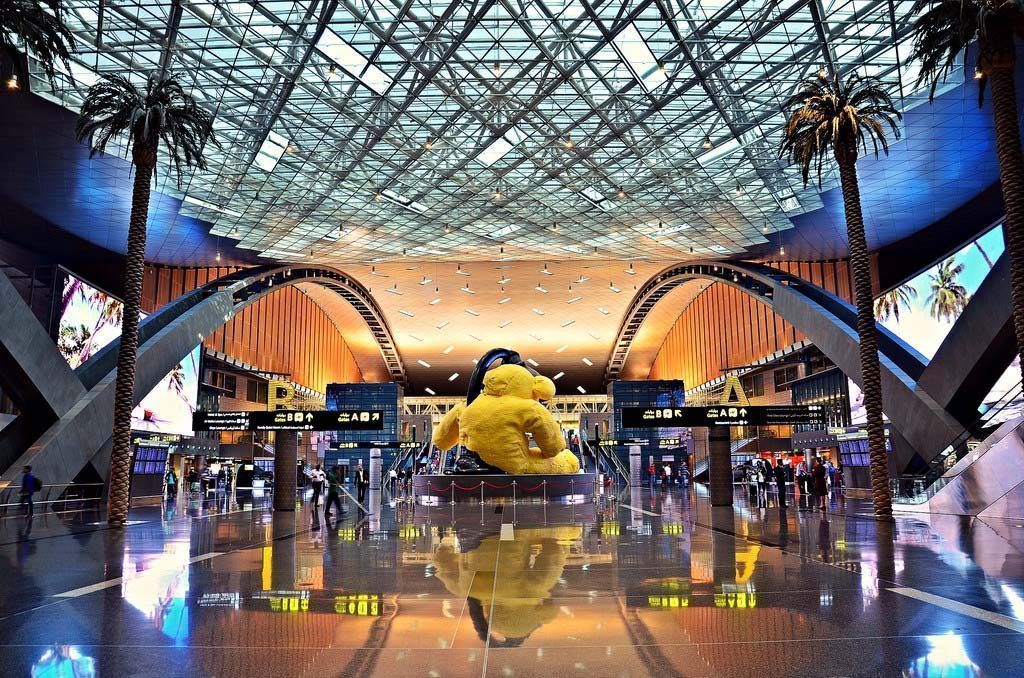Tasked with the position of main point of contact between the Gulf country and an estimated 1.2 million visitors from around the globe, Qatar’s airports are set to witness flights surge from 700 per day to 1,600.
Reports over Qatar’s Hamad International Airport and its alleged lack of preparedness for an anticipated surge in aviation traffic during the upcoming 2022 FIFA World Cup has come under fire by experts as “misinformed”.
The Daily Mail’s Sportmail report on Monday criticised Qatar’s main airport, suggesting it “is not prepared for a large flow of travellers”.
Often slammed by the public as a sensationalist tabloid, the Daily Mail dubbed the alleged learnt information as “devastating” which, it added, “raises grave questions ahead of the event, which kicks off next month.
“This newspaper has been told a desperate hunt for staff has seen many drafted in from across the globe, with officials now in a race against time to get them trained to the required standard,” the report adds.
However, aviation analyst, Alex Macheras, stepped in to provide his insights on the critical report with a “fact check” saying: “Doha’s Hamad Intl Airport is the super-hub airport gateway in the Gulf connecting millions of the world’s passengers as a global transit point with one of the world’s highest air travel performance ratings, dispatch reliability & highest staff to passenger ratios.”
Addressing the Daily Mail journalist, Macheras said they could have had a greater understanding of air traffic in the area had they visited Qatar and seen the massive aviation operation, especially overnight when it witnesses an endless stream of transit flights going in and out, as East to West and vice versa.
In June, the international airport was awarded the World’s Best Airport for the second year by the Skytrax 2022 World Airport Awards.
Spanning 22 km2, the spacious Hamad International Airport operates 41 contact gates and 65 remote stands (73 remote stands including MAGS). It currently serves over 39 million passengers per year with a 600,000m2 terminal, providing a luxurious experience for visitors landing at the facility.
The airport is also 12 times larger than the old Doha airport, which has been reopened to accommodate the influx of passengers for the tournament.
Other experts have also slammed the misleading report and shed light on Daily Mail’s headquarters host nation, and its Heathrow Airport as a more viable point of research due to its travel chaos.
“Judged by this misinformed alarmism of this Daily Mail journalist he must have done his research at London Heathrow and not Hamad International which has been a far more reliable transit hub than any UK airport over the past couple of years,” said Dr. Andreas Krieg, an associate professor at King’s College London on Twitter.
The Daily Mail report went on to claim that some employees are concerned that the extra traffic will make ‘already-pressured’ staff unable to handle the change as the activity is expected to more than double.
London’s Heathrow Airport was recently brought under fire by Qatar Airways CEO Akbar Al Baker over its lack of foresight in aviation traffic.
Speaking to Bloomberg earlier this year, Akbar Al Baker said Heathrow airport should have better calculated the disruption to flights this summer and provided airlines with a notice of the need to curtail schedules.
Representing the Mideast state’s sovereign wealth fund on the Heathrow board, Al Baker told Bloomberg Television he understood that the hub is confronted with staffing problems, however was “disappointed” by its lack of foresight.
“Heathrow has the right to restrict your flight because they cannot overload their facilities,” he said in an interview at the Farnborough International Airshow on Monday.
“But my question to the management would be, they should have seen this coming and they should have taken mitigating actions.”
The move, which saw thousands of bags pile up at the airport, “angered” airlines that were forced to clear out flights during the peak summer season.
One such frustration was echoed by UAE flag carrier Emirates President Tim Clark who suggested he would abstain from adhering to those restrictions before ultimately reaching an agreement.
The London based airport was also criticised for mismanagement of its capacity this summer. Offering an apology, as reported by Reuters, Heathrow Airport apologised in July for “unacceptable service in recent weeks, with long queues, delays for those with reduced mobility and baggage issues, as it struggled to cope with 40 years of passenger growth in four months”.
Aviation analyst Macheras further highlighted Qatar’s own airspace FIR, which does not rely on Bahrain, saying: “it IS true that this year the world has witnessed a major airport hub overwhelmed, understaffed & completely unable to cope with an ordinary number of passengers…and that airport’s name is London Heathrow.”
The Daily Mail’s report comes as Qatar in late August expanded its airspace for the first time in history through the agreement Doha signed with Saudi Arabia, Bahrain, and the UAE over the activation of the Doha Flight Information Region (FIR), the country’s own airspace.
Signed by the Qatar Civil Aviation Authority (QCAA), the agreement links all of the signatories’ FIRs and came into effect on 8 September. The agreement comes after a previous deal signed between Qatar and Iran in April.
The FIR would enable the Gulf state to expand its current sovereign airspace into the UAE, Iran, and Bahrain, while achieving safe and sustainable air transport operations in the region.
The airspace is the first to ever be established for Qatar, redrawing the skies of the world’s airspace map for the first time in decades. The Doha FIR would shrink Bahrain’s airspace and extend to the UAE and north towards Iran.
One outcome of the Doha FIR is that up to 70% of flights heading to the UAE will pass through Qatar’s airspace.
With a new FIR of its own, Qatar gains much-needed airspace independence, and the country will have the ability to maximise the efficiency of air travel around Qatar in order to better meet its air travel sustainability goals.
The latest development in the establishment of the Doha FIR also comes just weeks ahead of the 2022 FIFA World Cup, where shuttle flights will take off between countries in the region to transport eager football fans.
Qatar has also been among the leading countries in the aviation industry as it recently won last week the membership of the International Civil Aviation Organisation (ICAO) Council for the first time in historic after garnering 160 votes.
According to Macheras, “aviation-focused” Qatar would now be joining other member states including the US and Singapore on the table of other decision-makers “for the global aviation policy”.
What do locals think?
Despite the state-of-the-art features, locals in Qatar earlier this year identified areas in which improvements can be made to Hamad International Airport.
Some 83% of those who took part in the survey agreed that HIA deserves its recently-awarded titles, though many still said the facility is not ready to welcome an expected influx of visitors in less than five months’ time.
Among the voter’s biggest concerns are limited check-in counters and long passport control lines. 53% of voters in Doha News’ survey said that the check-in counters at the airport are not enough, noting lines for flights are too long, especially in peak holiday seasons.
As for the ‘luxurious’ experience promised, many stated that lounges are full most of the time, leaving little to no space for visitors to relax while waiting for their flights.
“The lounges are always packed. They’re too small for the airport capacity and even the food options are very limited and pricey,” one resident said.







